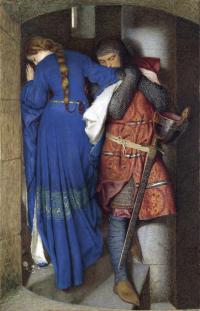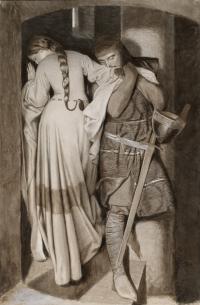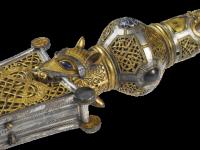Ireland’s favourite painting:The meeting on the turret stairs
Published in Anglo-Norman Ireland, Features, Issue 5 (Sept/Oct 2012), Medieval History (pre-1500), Volume 20
Hellelil and Hildebrand. The meeting on the turret stairs (1864), by Frederic William Burton (1816–1900), recently voted Ireland’s favourite painting. The highly finished preliminary study (opposite page) in washes is larger than the final watercolour. It was discovered during conservation, under the cartoon of Burton’s Cassandra Fedele (1869, NGI.2385), for the final work in Dublin City Gallery: The Hugh Lane. The drawing demonstrates how precisely Burton worked out each detail of the painting, and while there are some variations in the preparatory studies (c. 30 are known), they all represent this exact moment of the couple meeting on the turret stairs. (National Gallery of Ireland)
The inspiration for the painting was a ballad or poem ‘Hellalyle and Hildebrand’ that appeared in ‘A second batch of Danish ballads’ translated by Whitley Stokes from Danske Viser, vol. iii, 353, published in Fraser’s Magazine 51 (January–June 1855), pp 88–9. Whitley was the son of Burton’s friend William Stokes, and his note accompanying the ballad summarised Wilhelm Grimm’s translation (1811) of the same story from a Swedish visa (folk song), ‘Hilla Lilla, who wails over her brother’s hard treatment’, similar to the Danish ballad. The painting reflects Burton’s sensitive nature in avoiding references to bloodthirsty or sexual scenes. Illustrating a strong interplay between text and image, it is frequently referred to (and can be interpreted as) a parting after Hellelil and Hildebrand have consummated their forbidden love. But it was not in Burton’s character to depict such a scene. A careful reading of the ballad reveals an imagined early moment in the relationship when the couple meet fleetingly on the stairs, as Hildebrand passionately seizes Hellelil’s arm, embracing it and making the most of a brief encounter in a doomed affair. In the words of George Eliot, ‘The face of the knight is the face of a man to whom the kiss is a sacrament’. Burton creates an emotionally charged situation—by focusing attention on the knight’s intense embrace of the arm of his lady, who, taken by surprise, turns aside, having dropped her flowers, scattering the petals on the stair—symbolising the brevity of the affair and its destructive nature. The Times art critic, probably Tom Taylor, referred to it as ‘a personification of that lofty woman worship, which was the very heart of chivalry’ (25 April 1864). Neatly scribed on a stone beside the stair is the signature ‘FWB 1864’.
Technique
Burton was left-handed owing to a childhood accident to his right arm, painted only in watercolour (not liking the smell of oils) and had problems with his eyesight. It was his practice to work out the composition in preliminary studies, including full-size sketches, of which the National Gallery has both a cartoon (NGI.2384) and a preparatory study (NGI.2386, above), before embarking on the final work. Drawing on his background as a miniaturist, Burton painted the watercolour by building up depth in small, delicate brush-strokes (similar to painting portrait miniatures and illumination), the faces modelled in subtle hues (similar to pastel) to achieve the overall tone. Gum Arabic is used to give substance to the hair, just as opaque gouache highlights add texture to the chainmail and helmet. A meticulous worker, he took extraordinary care over the supports and frame; as a result, the painting is stable in its original gilt frame, in accordance with his instructions: ‘It is my desire that this picture should never be removed from the board on which it is fixed, nor can be mounted or framed otherwise than done’ (September 1864). The nostalgic mood, the period setting and costume show affinity with the Pre-Raphaelites, as does Burton’s restraint in conveying his subject in an understated manner to avoid the excesses of melodrama.

preliminary study
Stylistic influences
The Pre-Raphaelite Brotherhood (1848) was formed by seven artists, including John Everett Millais, William Holman Hunt and Dante Gabriel Rossetti, with Ford Madox Brown a close ally, and promoted by the critic John Ruskin into a vital artistic movement of the mid-Victorian era. These artists looked to medieval legends and literary themes, using their commitment to realism and naturalism to depict heightened emotional states. Burton knew Rossetti but was closest to Edward Burne Jones, who shared his scholarly approach to art history and painting, reflecting a similar refinement in colour and tone. His knowledge of German Romantic painting, especially the Nazarenes, made him receptive to the later phase of Pre-Raphaelitism. A number of early paintings by Millais bear close comparison to Burton’s picture, notably Mariana (1851), in the silhouetted figure evocatively dressed in deep blue and wearing a similar belt, with leaves scattered about her feet, and the couple expressing tragic love in Millais’ popular Huguenot (1852). Had Burton taken a different approach to the poem, he might have depicted Hellelil as a ‘fallen woman’, a theme being explored by several Pre-Raphaelite painters at this time, notably in William Holman Hunt’s The Awakening Conscience (1853). Instead, Burton observed the emotionally charged exchange between the brother and sister in Hunt’s figurative composition Claudio and Isabella (1850). The artist may have been struck by the heightened emotion of a couple passionately kissing on a stone staircase in Il Bacio (1859) by Francesco Hayez, the Italian exponent of historical Romantic painting. Burton, however, thought carefully about his composition, creating an evocative image by employing a combination of medievalism and naturalism and imbuing it with his sense of refinement of colour and tone.

Detail from the base of the Cross of Cong, showing the animal head that inspired the one on the noseguard of the knight’s helmet in Burton’s painting. Burton studied the cross after its presentation to the Royal Irish Academy by Professor James MacCullagh of Trinity College Dublin in 1839. He may also have seen Henry O’Neill’s (1798–1880) views of the Cross of Cong published in the Kilkenny Archaeological Journal (1855). (National Museum of Ireland)
Medieval background and setting
All the preliminary studies show a medieval tower as the setting for the picture; the direction of the stairs is accurate in being clockwise, like an Irish tower-house, just as the view is correctly taken from a chamber doorway looking towards the stairs. The artist was vigilant about accuracy, incorporating a late medieval loop window made of a narrow vertical slit in the wall, splayed on the interior so that it could be used by archers. Similarities can be drawn with Daniel Maclise’s Portrait of Sir Francis Sykes and his family (1837), with its turret stairs, loop window and armoured knight.The figure of Hellelil draws especial attention, her elongated back view emphasising the costume, with only a glimpse of the face and outstretched arm. The particular shade of deep blue was also used in Burton’s The Child Miranda (1864). The gown appears made of fine wool, with long hanging sleeves fringed in fur, fitted with a tight bodice down to the hips, creating an elegant outline majestically folding into an extremely full skirt, both the sleeves and gown lined in white fur. The decorative girdle about her waist is of a generic late medieval type, its band interspersed with a sequence of bronze buckles, linked so that it could move with ease on the hips. Wound around her golden hair are mauve ribbons that end with the hair woven into a mauve toggle, tucked into the belt. It is not known who the models were who posed for the picture.The knight wears a knee-length chainmail shirt with arms extended to incorporate mittens, which were accessed through a slit at the wrist. Underneath are breeches with blue woven leggings, and on his feet are tanned leather pointed-toed shoes with a cutting in the hide secured with a leather thong. On top is a loose-fitting, sleeveless mid-calf surcoat (over-tunic), worn by knights over their armour (protecting the mail from the sun), slit at the front and back at thigh level for ease of movement. The surcoat, of red-orange with a mauve hue, is richly embellished with decoration picked out in gold threads and in black and white, interspersed by regular bands of black and white. A rose cord tied at the front keeps the garment in place. Suspended on his arm by a leather cord is a leather-lined conical helmet with a decorative band in bronze or gilt bronze, ending in a noseguard featuring an animal with ears on the back of its head. Burton had studied interlace before, using this feature in 1845 when designing an Irish gold and emerald fibula based on an antique Celtic model, commissioned as a gift for Helen Faucit and executed by West & Son, Dublin, in 1846–7 (National Museum of Ireland). The animal on this noseguard, however, is inspired by the animal head on the base of the Cross of Cong, which Professor James MacCullagh (1809–47) presented to the Royal Irish Academy in 1839, the Cross design reflecting Viking Urnes art-style influence. Burton would have studied this treasure when he was on the council of the Royal Irish Academy in 1846–52, and he undertook a drawing of MacCullagh (NGI.2031) after his death in 1847. Around his waist the knight wears a leather belt from which is suspended a sword with a brass ‘fishtail’ hilt of a thirteenth- or fourteenth-century design and cross-guard, the twisted wire of the hilt faithfully shown. The leather sheath of the brass scabbard has hints of Celtic La Tène scabbard ornament, painted to suggest gold, silver and niello (a sulphur-based black compound), its linked running triskele pattern perhaps based on a Romanesque model that Burton saw in the South Kensington Museum (Victoria and Albert) or the British Museum. A striking feature of both costumes is the embellishment. The red-gold decoration on Hildebrand’s surcoat may be of Byzantine or Eastern silk, with patterned roundels of harpy-like winged figures and interlocking snake-like tails. These fabrics found their way into European church treasuries and museums, such as the Victoria and Albert. They also recall silk remains found in Viking graves at Durham and Canterbury cathedrals. Hellelil’s gown is Scandinavian, with its decorative appliquéd band of S-style acanthus decoration and bird motif in white and blue on a green ground, a type also found in Viking silk remains. While Burton was familiar with Viking Urnes ornament, the design might also have been drawn from Owen Jones’s Grammar of ornament (1856). Jones was a friend of George Eliot, who reviewed this book for him.
The peak of his career
Burton’s famous picture was painted when the artist was at the peak of his career. Every element of the composition, from the preliminary studies to the completed work, illustrates the meticulous attention to detail of an artist who was a perfectionist. The watercolour demonstrates Burton’s considerable knowledge of antiquity and the medieval world, painted with his distinctive sense of refinement of colour and tone.In 1900 the Gallery mounted a retrospective exhibition of 104 of Burton’s drawings and watercolours, and over a century later Burton remains one of Ireland’s major nineteenth-century painters. His native country never lost its place in his affections; as he remarked to Lady Gregory, ‘My best joys have been connected with Ireland’. HI
Marie Bourke is Keeper and Head of Education at the National Gallery of Ireland.
Acknowledgements
Mai Blount, Clare Browne, Tom Dunne, Andy Halpin, Elizabeth Heckett, Anne Hodge, Griffin Murray, Raghnall Ó Floinn and Niamh Whitfield.
Further reading
M. Bourke, ‘Frederic William Burton, painter and antiquarian’, Éire-Ireland 28 (3) (1993), 45–61.M. Bourke, ‘New research on Burton’s Meeting on the Turret Stairs’, Review of the Pre-Raphaelite Society 20 (3) (Autumn 2012).C. Cruise, Pre-Raphaelite drawing (London, 2012).G. Murray & P. Ó Riain, ‘The Cross of Cong: recent discoveries’, Archaeology Ireland 19 (1) (Spring 2005), 18–21.


















